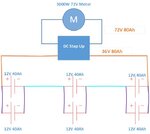Jvdwalt
Newbie level 1
Hi,
I’m pretty new when it comes to electronics and efficiency. I apologise in advance if this is a stupid question.
I would like to know which of the following two scenarios would give me a longer time to run the motor attached to the batteries, if there is a difference.
Senario 1:
6 X 12V 40Ah batteries connected in series to provide 72V 40Ah to a 3000W 72V DC motor.

Senario 2:
3 clusters of 2 X 12v 40Ah batteries connected in parallel and the clusters connected in series to create a 36V 80Ah source. Then adding a Dc step up circuit to boost the volts to 72V and run the 3000W 72V motor from that.

Would I get the same result in these two scenarios?
Any help would be greatly appreciated.
I’m pretty new when it comes to electronics and efficiency. I apologise in advance if this is a stupid question.
I would like to know which of the following two scenarios would give me a longer time to run the motor attached to the batteries, if there is a difference.
Senario 1:
6 X 12V 40Ah batteries connected in series to provide 72V 40Ah to a 3000W 72V DC motor.

Senario 2:
3 clusters of 2 X 12v 40Ah batteries connected in parallel and the clusters connected in series to create a 36V 80Ah source. Then adding a Dc step up circuit to boost the volts to 72V and run the 3000W 72V motor from that.

Would I get the same result in these two scenarios?
Any help would be greatly appreciated.
Last edited by a moderator: